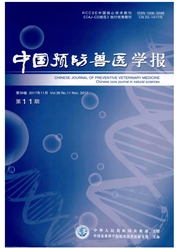

 中文摘要:
中文摘要:
为研究本实验室制备的抗马传染性贫血病毒(EIAV)p26蛋白单克隆抗体(MAb)1G11的B细胞表位识别特性,本研究通过对不同EIAV株p26蛋白进行系统进化分析,将其划分为3大分支群。根据已经鉴定的线性表位(命名为1G11),通过对3个分支群中的8株代表性病毒株p26蛋白1G11表位区域分析,并原核表达8株病毒1G11表位区域多肽P26-(1~8),经SDS-PAGE和western blot鉴定,结果表明除表位多肽P26-7以外,其他多肽均能够被MAb 1G11所识别。分析显示P26-7多肽序列同时发生N^200S和M^215L变异。由于N^200S和M^215L单独改变并不影响MAb 1G11识别,因此我们推测N^200与M^215同时改变可能影响两侧末端半胱氨酸(C)及附近氨基酸所形成的表位构象,进而影响MAb 1G11识别;同时,其他氨基酸差异并不影响MAb 1G11识别,表明该抗体对1G11表位区域识别具有广谱性。这为进一步应用该MAb作为检测抗体和开发广谱性诊断检测方法提供了依据。
 英文摘要:
英文摘要:
To identify the diverse epitopes recognition of MAb 1G11 against p26 of equine infectious anemia virus (EIAV) prepared previously in our laboratory, a total of 8 polypeptides (P26-1 to P26-8) of diverse epitopes of p26 in different EIAV strains, which represented 3 genotype groups based on capsid sequence phylogenetic analysis, were expressed in E.coli according to MAb 1G11 recognizing a linear 21-amino acid sequence (designated as epitope 1G11) and subjected to western blot analysis with the MAb 1G11. Then, the identification results showed that, except for P26-7, all the rest polypeptides were positively reacted with MAb 1G11. With the sequence analysis, somechanges in the region were unlikely to impact on the antibody recognizing the epitope 1G11 region. However, the MAb 1G11 failed to specific bind to P26-7 when both of N^200S and M^215L were substituted in theregion. Therefore, it was speculated thealterations of both N2^00S and M^215L impaired the conformation formed by adjacent C and associated amino acids of both ends, and disrupted the epitope conformation. In conclusion, the MAb 1G11 had a broad spectrum affinity tothe diverse epitopes from different genotype EIAV strains, which could be application for development of the detection assay for EIAVs.
 同期刊论文项目
同期刊论文项目
 同项目期刊论文
同项目期刊论文
 Core-Binding Factor Subunit Beta Is Not Required for Non-Primate Lentiviral Vif-Mediated APOBEC3 Deg
Core-Binding Factor Subunit Beta Is Not Required for Non-Primate Lentiviral Vif-Mediated APOBEC3 Deg 期刊信息
期刊信息
